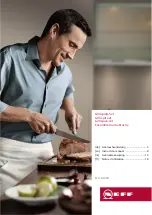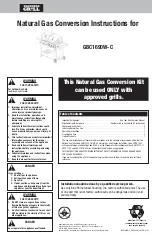
ENGLISH
8
OPERATING INSTRUCTIONS
INTRODUCTION TO CERAMIC GRILLING
Ceramic charcoal barbecues are extremely versatile. Not only can they be used for grilling or smoking, but also pizzas, bread,
pies and cookies can be baked effortlessly inside them. Due to their excellent heat-retention properties, high temperatures can
be achieved and maintained by precise control of airflow via the top and bottom vents. High temperatures are ideal for quickly
cooking burgers and sausages, while low heats can cook larger cuts over a longer period of time. Try adding some wood chips to
the charcoal, or try combining different flavour wood chips to make your meats even more flavourful.
GRILL TEMPERATURE RANGES
Temperature readouts on the control board may not exactly match the dome thermometer. All temperatures listed
below are approximate and are affected by the following factors: outside ambient temperature, the amount and
direction of wind, the quality of fuel being used, the lid being opened, and the quantity of food being cooked.
•
HIGH TEMPERATURE (205+°C / 401+°F)
This range is best used to sear and grill at a high heat. High temperature is used to preheat your grill, burn-off the cooking
grids, and to achieve high heat in extreme cold weather conditions.
•
MEDIUM TEMPERATURE (135-180°C / 275-356°F)
This range is best for baking, roasting, and finishing off that slow smoked creation. Cooking at these temperatures will
greatly reduce the chances of a grease flare-up. Great range for cooking anything wrapped in bacon, or where you want
versatility with control.
•
LOW TEMPERATURE (80-125°C / 176-257°F)
This range is used to slow roast, increase barbecue flavor, and to keep foods warm. Infuse more flavor and keep your meats
juicy by cooking longer at a lower temperature (also known as
low and slow
). Highly recommended for the big turkey at
Thanksgiving, juicy ham at Easter, or the huge holiday feast.
TIP: When smoking, open the bottom vent fully and leave the lid open for about 10 minutes to build a small bed of
hot embers. Monitor the ceramic charcoal barbecue until it has risen to the desired temperature, leave the bottom
vent slightly open. Close the top vent and continue to check the temperature for a few more minutes.
The key is to experiment with the length of time you allow for smoking, before the meal is finished cooking. Some outdoor chefs
prefer to smoke at the end of a cook, allowing the food to keep warm until ready to serve. Practice makes perfect!
UNDERSTANDING AIRFLOW AND DAMPER CONTROL
The heart of your grill lies in the relationship between the top and bottom ventilation dampers. Opening the dampers, allowing
more air to flow through the system, allows the charcoal to burn very hot and create firey embers. To cook at lower temperatures,
keep the dampers open only a small distance, allowing for minimal airflow and maximum heat retention in the ceramic chamber.
To ensure the grill performs correctly, proper maintenance and cleanout of the firebox are essential. If the grill is not achieving the
desired temperature, check to ensure that there is proper airflow to the fuel and that none of the dampers are blocked.
TIP: The grill can run efficiently over extended periods of time as long as there is dry and sufficient fuel, proper airflow, and
the cooking components are clean.
FIRST USE – GRILL BURN-OFF
Curing your ceramic charcoal barbecue is important for its long-term operation and care. Avoiding the curing procedure could
lead to damage on the unit. If the first burns are too hot, they could damage the felt gasket seal before it has had the chance to
mature with use. To start your first fire:
1. Place one lighter cube, or solid firelighters and one handful of lump charcoal on top of the charcoal plate. Open the
bottom vent and light the lighter cube using a long-nosed lighter or safety matches.
Содержание PBK24
Страница 61: ...ESPA OL 60...









































